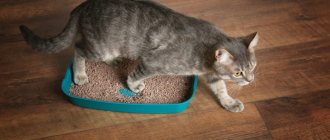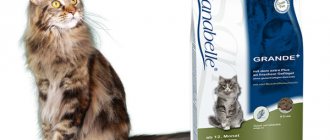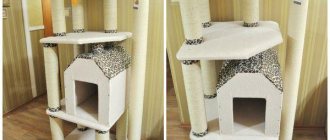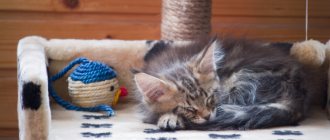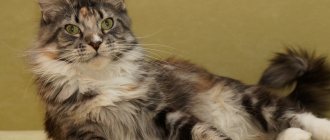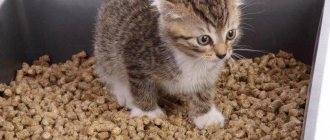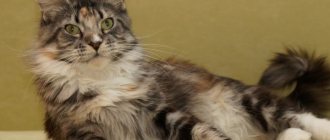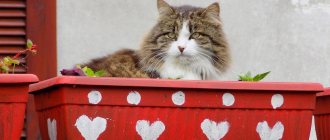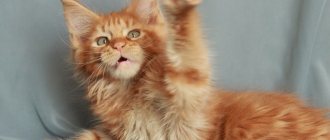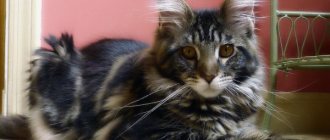Maine Coons are large, active cats with a playful character. Therefore, the “potty” for a pet of this breed must correspond to the considerable size of the animal, and its design must minimize the mess caused by the coon when visiting the toilet. The minimum dimensions of a tray for Maine Coons are 40x80 cm, the height of the sides is at least 10 cm. In addition, the tray must be stable.
For a kitten just brought home, it is recommended to purchase a tray of the same type that was in the nursery. A child experiences serious stress when moving, so it is important that objects familiar to him from his previous home appear in his new environment. Soon the tray will have to be changed anyway - the Maine Coon will grow up, and the old “potty” will be cramped for him.
Top 10 cat litters
The rating is presented by models that our editors recognized as the best in their segment (traditional, with a grate, with high sides, a toilet-house, a composting toilet, an automatic toilet and a travel tray). Each model has a brief description, approximate cost and a link to the store where you can buy the tray.
| Model name | Price | Description | Shop |
| Savic Iriz M (traditional tray) | 200 rub | Deep tray with sides of increased height Dimensions (mm): 420 × 305 × 100 | To the store |
| DD Style “Dogush” (with grille) | 440 rub. | Capacious tray with a removable mesh made of high-quality plastic, 3 color options Dimensions (mm): 325 × 430 × 155 | To the store |
| SAVIC Aseo Jumbo (high sides) | 1340 rub. | Tray from a Belgian manufacturer. The shape of the tray and high sides are suitable for cats that like to miss the mark when going to the toilet Dimensions (mm): 675 × 485 × 280 | To the store |
| SAVIC Nestor (tray house) | 1260 RUR | Contents: tray itself with door and filter. Suitable for large cats Dimensions (mm): 560 × 390 × 385 | To the store |
| Imac “Zuma” (closed tray) | 2850 rub. | Equipment: tray box, removable frame, carbon filter, shovel and compartment for toilet bags Dimensions (mm): 400 × 560 × 425 Colors: ash pink, blue, beige gray | To the store |
| Ferplast “Jumpy” (top entrance) | 2600 rub. | Enclosed deep litter box with top entry that prevents other pets from accessing the litter box Dimensions (mm): 388 x 575 x 390 | To the store |
| Curver “Pet Life” (dry toilet) | 4253 RUR | Equipment: tray box, scoop, mesh for tray, carbon filter, beautiful appearance Dimensions (mm): 510 × 390 × 400 | To the store |
| CatGenie 120 (automatic toilet) | RUB 32,900 | The price is indicated without replacement filters and filler. Full set – 47,900 rubles. The highest degree of automation of the cat litter cleaning process at a considerable cost Dimensions (mm): 600 × 500 × 550 | To the store |
| Show-Pets (road) | 689 RUR | A travel folding tray with a zipper is an indispensable thing at an exhibition, on the road or at a party Dimensions (mm): 200 × 300 × 110 | To the store |
| Disposable tray Siberian cat “Super” | 251 RUR | Disposable litter box for cats - an alternative to a travel litter box, filler included | To the store |
Selecting a tray
Purchasing a convenient tray will allow you to quickly make friends with the new furry resident of your home. The most common problem with keeping a Maine breed in an apartment is that cats love to rummage through litter. As a result, over time, a kind of “frame” of filler forms around the tray, grains of which can then be found throughout the apartment. A large cat needs a large litter box.
But how to choose it?
It is better to choose a tray according to the character of your pet. The main types of cat litter that can now be found in stores.
This option is better suited for small kittens who are just learning to go to the toilet.
Tray with high sides
This option is slightly better than the previous one, however? For a real Maine cat, it is not difficult to scatter particles of litter from it. Experienced owners of large cats recommend placing such a tray in another plastic box in order to localize the place where the litter spills.
Closed tray
This is the best option for a Maine cat. Most often, such a tray is a closed container with a door. In the photo you can see that modern closed cat litter boxes are equipped with special filters for air purification and other innovations. At the same time, even a toilet house without any special bells and whistles will be an excellent purchase. The pet feels calm inside such a toilet, and the smell and dirt do not spread throughout the house.
Which toilet is better and why?
The size of the cat potty should correspond to the weight of the Maine Coon, so that the cat does not feel constrained and can freely scoop up the litter. A closed litter box with a door is suitable for this breed. The pet will be able to calmly, without distraction, go to the toilet, without scattering the litter throughout the room. An open box is also suitable for tailed pets, but it is better to give preference to large containers for Maine Coons with sides, since cats of this breed love to dig into the litter. The sides in these toilets are installed with the edges going inward to avoid clutter. Household plastic basins and Maine Coon bowls with high sides are also used as toilets.
Rectangular plastic box with small sides
A plastic tray is suitable for small cats, but it will not be convenient for an adult.
It is a plastic pot without sides and additional functions that help keep the room clean. That is why the contents scatter and spread throughout the apartment. The tray is uncomfortable for an adult cat, although it is ideal for kittens. Easy to wash and does not take up much space. Trays with a grid for draining urine, under which the filler is hidden, are in demand, while the pet does not come into contact with the contents of the toilet and does not taste it.
Open box with sides
This type of bowl is suitable for adult cats, equipped with additional sides, and looks like a box. This toilet attracts cats with its appearance and large size. The inwardly curved sides help owners avoid clutter around them by preventing the spread of filler. However, such a toilet does not eliminate the smell of the contents.
Closed tray
A tank-like box with a door. It is important that the size of the Maine Coon tray is large enough and convenient for cleaning. A closed house has special advantages over the types listed above:
- Delays the spread of unwanted odor from the box throughout the apartment.
- An animal visiting the toilet is not distracted by external factors while being inside.
- Tray houses are equipped with special carbon filters that absorb the smell of cat feces.
Subtleties of education
To minimize the risk of your Maine Coon wandering off anywhere, limit his movements during the first month, leaving access to the litter box, kitchen, hallway, bathroom and one room.
Allowed Methods
At the first sign of anxiety (the cat is spinning and meowing), move it to the tray and place it on the bottom. Lightly rake the litter as cats do.
As soon as the Maine Coon goes into the tray, praise and pet him, reinforcing the skill. If your pet does not have time to reach the tray, blot the puddle with a napkin and put it in the tray: its smell will orient the cat next time.
Prohibited tricks
Making your cat nervous will only delay the process of litter box training. In the arsenal of erroneous methods:
- screaming, irritation, swearing;
- physical punishment;
- repositioning the tray;
- fillers with sultry aromas.
Special advice to those who like to “poke the cat with its muzzle”: this trick will not work with a Maine Coon (it is not known who will poke whom).
How to fill a litter box for a Maine Coon?
Cat litter is selected taking into account the pet’s personal habits, which are usually acquired in early childhood. Therefore, when taking a baby kitten home, it makes sense to find out from the breeder what litter is used in the nursery.
Many Maine Coon owners pay attention to the fact that, ideally, a kitten should be taught to go to the litter box without litter.
This is important in cases where you need to collect tests
You should not put too much litter in Maine Coon litter trays - these animals with large paws love to dig in their “potty”, causing all the excess contents of the toilet to end up on the floor.
Of course, for the owner of a Maine Coon, it is more convenient to use litter that can be immediately disposed of by throwing it down the drain (for example, wood litter), but it is not a fact that the pet will immediately approve of this choice. The animal is gradually accustomed to the new filler - usually no difficulties arise, but there are stubborn individuals who do not want to change their preferences. In such cases, all that remains is to come to terms with the cat’s will.
Each type of filler has its own pros and cons, so the choice is up to the Maine Coon and its owner:
Wood filler can be thrown into the toilet; it is inexpensive, but it is quickly consumed and litters the room if there is no mesh on the tray. Mineral and clay fillers absorb moisture, but they cannot be thrown down the drain, and they also generate a lot of dust and dirt. Silica gel fillers are not cheap, but they are used sparingly and last a long time
They should not be thrown into the toilet and should be used with caution if there is a kitten in the house - a small coon can play with the granules and swallow them.. In no case should you use sand brought from the street as a filler
Under no circumstances should you use sand brought from the street as a filler.
The tray for Maine Coons must be cleaned 1-2 times a day and, when dirty, washed with a special disinfectant (you can buy it at a pet store). Maine Coons are very clean cats; they do not tolerate sloppiness and will certainly remind the owner that it is time to put their “conveniences” in order. You also need a scoop for removing lumps and excrement, as well as small plastic bags - in order to immediately throw the “neutralized” dirty litter into the trash bin.
Where to put?
Its location plays an important role in toilet training a furry pet. Since the tray for Maine Coons is quite large, it is not always possible to place it in the restroom. An alternative location will be the corridor. The tray can also be placed on a glassed-in loggia. But in this case, the pet must have constant access to it. In addition, the cat litter should not be located in the aisle or where there are drafts.
It is important that your pet feels safe and comfortable in the litter box. He must get to the toilet without obstacles from any corner of the home.
It is necessary to clean your cat's litter box regularly. For these purposes, you can purchase a special safe disinfectant, which is sold at any pet store. The fact is that a dirty litter box can cause rejection in a Maine Coon, since raccoon cats have a very sensitive sense of smell. Sometimes owners give their pets two trays - for “big” and “small” matters.
For the intricacies of choosing a tray and filler for a Maine Coon, watch the video below.
Selecting the right tray and fillers for the Maine Coon
Maine Coons are distinguished by their large size and playful, active character. Therefore, choosing a suitable tray for cats of this breed may not be as easy as if we were talking about a smaller pet. What are the options for trays and litter for Maine Coons and how can you choose from all their variety the one that your cat will be happy to use?
And is it possible to quickly and easily teach a Maine Coon kitten to use the cat litter box intended for it, and not leave puddles and piles in places not intended for this?
Nowadays, you can easily choose a tray for a cat, since their range is very diverse in terms of design and color, so it’s not difficult to choose a tray that matches the color of the interior of the room where it will be placed. But in order to choose the right litter box for your Maine Coon, you need to know the advantages and disadvantages of each type of litter box.
Rectangular with low sides
But it is completely unsuitable for adult Maine Coons.
After all, these cats love to dig up litter.
Because of this, the granules will scatter far from such a tray every time your pet visits it.
For a small kitten of this breed who is just beginning to learn the “wisdom of the toilet,” such a tray will be very good. Kids are not afraid of its appearance, and the low sides allow the kitten to use it independently.
With high sides
Trays of this design often have additional sides that increase their height even more. For Maine Coons, such a tray is quite acceptable, since the high sides prevent the litter from scattering even if the pet vigorously rake it. In addition, cats like litter boxes with high sides as they create the illusion of an enclosed space and make them feel confident and safe.
Closed house
One of the advantages of this design is that there is almost no unpleasant odor in the house from such a cat litter box.
After all, trays and houses are often equipped with carbon filters that absorb animal odors. Cats, as a rule, willingly use such trays, since in the toilet-house nothing distracts them from the process.
The disadvantages of closed toilets include their high price compared to other trays and the fact that they are inconvenient to clean if the tray does not slide out or if the top part cannot be removed from them. Therefore, if you decide to buy a closed type tray, in the form of a house, then you need to choose the model that has a removable top or the one that is equipped with a retractable tray.
Video about choosing a tray and fillers.
Necessary measures to prevent accidents
And in conclusion, I want to voice a list of necessary measures that will prevent accidents that may happen to your pet.
Windows and vents
Maine Coons are natural hunters, so always make sure the windows are closed. 60% of Maine Coon deaths occur due to falling out of a window. Mosquito nets also will not protect the Maine Coon from falling out, because when throwing, for example, after a bird or butterfly flying outside the window, it will not be difficult for the Maine Coon to carry out this net with its massive body. Due to the elongation of their body and mass, Maine Coons do not always have time to roll over on their paws, so a fall even from a small height can end tragically.
The vent mode in plastic windows can also cause the death of a Maine Coon. A Maine Coon who climbs into a window falls into a trap from which he cannot get out, which entails multiple fractures and death.
Toxic substances and household chemicals
To avoid the death of your Maine Coon due to poisoning, you must ensure that all household chemicals and toxic substances in the house are securely closed or put away in places inaccessible to your cat.
Small things
The cause of death can also be small things that a Maine Coon can swallow. Which will subsequently lead to intestinal volvulus, gastric obstruction or gastrointestinal injury. These are things such as New Year's tinsel, parts of some kind of packaging (especially cellophane), candy wrappers, small plastic fragments and much, much more.
Finally, I want to say that this is only part of everything a Maine Coon needs, the rest you will find in other sections and articles of our satya.
Choosing a food bowl
The choice of a bowl for food must be approached with the utmost seriousness: even small kittens require a lot of food, so the container for food mixtures should be both spacious and convenient for the pet. It is advisable that the diameter of the bowl be 15–20 cm. As for the material, the best option would be ceramic or stainless steel. The second copy will be much cheaper. Don't forget to consider the presence of a rubber rim at the bottom. Otherwise, such a bowl will always slide on the floor.
The water bowl also needs to be selected wisely. Interestingly, drinking is a real ritual for Maine Coons. Before starting the process, he often rake the water with his paw. Some individuals even put their paw there, and then bring it to their mouth and drink. Accordingly, such a process is unlikely to be completed without water splashing. A much bigger problem awaits the owners of these huge pets when they reach adulthood. An adult Maine Coon will chase the water bowl around, spilling water everywhere. That is why the container must be spacious and stable. Some owners prefer to install a fountain for their animals.
How to train a Maine Coon kitten to use the litter box?
The main work on training a cat to use the litter box should be done while the kitten is still very small. If the baby has a mother, then most likely there will be no need to intervene - the cat will teach him herself, but in the case when a kitten is adopted from a breeder, responsibility for the future hygiene of the cat falls entirely on the owner.
How to teach a kitten to go to the toilet in the right place:
- Planting in a tray. The kitten itself will not think of going into the litter box, even a low one. At first, you will have to put it there as soon as the cat is about to defecate - this can be easily determined by its specific position.
- Determining the time for the toilet. Few cat owners know that an animal’s “toilet schedule” can be regulated and even slightly controlled through a steady supply of water before bed and a normal diet.
- Praise in a timely manner. Potty training your kitten isn't just about getting him to the right litter box, it's also about positively reinforcing the new habit. Praise the baby clearly and with a positive intonation, pet him, even if he didn’t actually do anything, but was simply brought into the tray by you.
What you definitely shouldn’t do is scold the kitten, much less hit it. This way you will not at all speed up the process of adaptation to new conditions, but only slow it down. The kitten does not understand for what specific reason you need him to go to the toilet in a certain place, so you can only persuade him through positive reinforcement.
What is a scratching post for?
Sharpening claws is not a game, not a prank, but a physiological need of all cats, both wild and domestic. Using this procedure, the cat puts its main weapon - its claws - into combat readiness, makes them sharp and clears them of dead tissue. In addition, the animal stretches out, stretching its back, and also marks its territory - between the toes of cats there are glands that distribute their personal scent, and the height of the scratches indicates the status of the animal.
But, if a cat living in natural conditions can sharpen its claws on a tree trunk, then an indoor pet is often forced to be content with carpets, wallpaper and furniture, which causes mixed emotions among owners. To prevent such troubles from happening, you need to purchase or make a scratching post yourself.
An evaluative look at cat litter boxes: advantages and disadvantages
Closed ones used to be a necessity when transporting animals or traveling. Having appreciated all the advantages and the incredible love of cats for these convenient toilets, the owners began to purchase them for use at home. This is because closed type trays have a number of advantages:
Privacy - the closed type allows you to privacy and hide from prying eyes.
- Hygiene - the smell does not spread throughout the apartment, but remains inside the house; in addition, the filler does not scatter on the floor.
- Accuracy - in some cases, cats may miss the edges, but this will definitely not happen with a composting toilet.
Cat litter with a beautiful appearance
Aesthetics - a beautiful appearance and a variety of designs will allow it to blend well with the interior.
If the arguments in favor of a closed tray are convincing, then you should know about the disadvantages before purchasing.
- Cost - the price of such trays is significantly high, depending on the size and additional elements in the design.
- Care - caring for them is more difficult than classic ones. It is necessary to constantly check the degree of contamination so that the pet does not stop visiting it. In addition to washing the tray, you need to wash the walls and lid of the toilet.
How to train?
The “getting to know each other” process begins from the first days of the Maine Coon’s appearance in the apartment. For a small “fluffy”, a miniature tray with low walls is suitable. The kitten will quickly get used to it. The baby is taken to the tray immediately after eating and is not released until he has done “his business.” After the pet does what is expected of it, the owner praises it and treats it with its favorite treat. Thus, the baby will understand that “friendship” with the tray is safe and even pleasant. If an “incident” did occur, and the kitten went to the toilet in the “wrong” place, then do not scold the pet. Calmly take the animal's waste products to the tray, clearly showing your pet where he should relieve himself.
As the cat gets older, the design of the trays will change. The process of “getting acquainted” with a new toilet for an older Maine Coon is similar. Over time, it will be easier for your pet to accept all the “innovations” in the apartment, and it will be much easier to accustom him to a different tray.
The cat shits in the wrong place
Features of the behavior and character of an adult Maine Coon and a kitten
Usatiy often combines criminal activities with legal ones, i.e. defecates both in and around the litter tray. Sometimes urine/feces in unauthorized places act as territory markers: this is what insecure animals do.
Reasons why a Maine Coon ignores its toilet:
- the cat doesn’t like the tray (shape, size, material);
- the cat is not satisfied with the placement of the tray;
- The cat is not happy with the litter.
You will return your pet to the right path by eliminating the root cause of the crime. The following will help eliminate odors on the floor/walls:
- disinfectant solutions;
- vinegar diluted in water;
- solution of potassium permanganate (weak);
- soda ash.
But if a cat urinates on the carpet, the latter will most likely have to be thrown away.
There are also preventive measures, which, however, do not work for everyone: lemon peels (in “dangerous” areas), special sprays, foil (whose rustling cats cannot stand) and tape (to which tailed animals really do not like to stick).
Physiological reasons
These include genitourinary diseases, colds, worms, constipation and other ailments. Only a doctor can make an accurate diagnosis. Therefore, before punishing your Maine Coon, take him to the veterinary clinic.
Psychological disorders
This category is represented by such cat emotions as:
- resentment;
- attention deficit;
- jealousy;
- revenge;
- sadness;
- high/low self-esteem.
Maine Coons can be anxious about renovations, moving, and even rearranging/buying furniture. Not finding the old marks, he will begin to mark the territory again. A cat can defecate in an apartment even after other animals appear in it in order to assert its rights.
Return to content
What will you need?
With the arrival of a small new tenant in the house, many different things that he needs will soon appear there. Among them are bowls for food and water, toys, a tray, scratching posts, play complexes, baskets for sleeping, and houses. It is not necessary to purchase exactly all the items on the first day. You need to start with the essentials. Considering that Maine Coons are quite large animals and grow quickly, all playgrounds, houses and other equipment should be spacious and comfortable for pets.
In addition to the essentials - bowls and a tray, the kitten immediately needs to purchase a scratching post, followed by a house, a play complex, and a sleeping place. You can buy everything together or choose just one. This depends on the desires and financial capabilities of the owner.
Toilet for Maine Coons.
Home / Automatic cat litter / Toilet for Maine Coons.
Filter
Come on quickly, don't drag your feet!
On this page, I will provide information on the progress of the construction of an automatic litter box for very large cats. Maine Coon is not mine, his image was downloaded from the Internet. If the author objects, then without delay, I will delete the picture (I will find a less scrupulous author!).
At the moment I have ordered a tray. The tray is larger than my wall-hung toilet. I hope the Maine Coon will have no complaints about him.
On Aliexpress, I ordered one “secret supplement”. A component that will increase flushing efficiency several times and leave no chance for excrement. There will be an intrigue here, which I will reveal after patenting.
After measuring the tray, I will begin cutting and assembling the body (this information turned out to be premature, since further events developed unexpectedly even for the author!).
Working on a tray in the country. There is a gradual transformation of the tray into a toilet.
Yesterday (05/12/2019) I went to pick up a power supply, which I ordered at 2:00 am. I arrived at the pick-up point, thought about it and took two! For the future.
I’m waiting for the main gadget, which keeps rushing around the vast country - it just won’t reach me!
The wait was prolonged. The parcel information has not been updated for two days now. While I'm waiting, I'm experimenting with the new tray, debugging the automatic release of water from the bowl. Today I decided to check at what minimum flow rate the flush will remain operational. The new tray for Maine Coons confidently “washed away” when water was supplied, with a flow rate of 1 liter per minute! Imagine this trickle! Up to this point, I usually tested at a flow rate of 6 liters per minute. Of course, a flow rate of 1 liter per minute is not practical from the point of view of flushing duration. It took 4 minutes for the bowl to fill. But, in older housing stock, the toilet should also work!
Testing automatic water discharge.
It's just some kind of holiday!!!
The gadget I ordered has arrived! I quickly (on my knees) assembled the water supply system and began testing! My intuition did not let me down! Now I can confidently say that with two liters of water I can clean a Maine Coon’s toilet, in one go and without any messes!
On plasticine, the system worked without failure. But, as earlier tests showed, plasticine is more difficult to wash off than cat feces. So my confidence is “reinforced concrete”!
After I assemble the system, I will shoot and post a video for demonstration.
Today I thought: “Why steal from cats what they no longer need and carry to the toilet, when you can invite the cats to carry all this to the toilet themselves.” As a result:
As I warned earlier, visually there are no differences from previous toilet models. But the toilet for Maine Coons has a completely different flushing logic. As in the joke: “Do you see a gopher?” "- No." “And he is there!” This toilet takes longer to clean and uses very little water! The whole toilet is woven from contradictions! It united: a horse and a tremulous doe.
The cats narrowed their circles around the toilet for half a day, and then they all checked out in small formations. Nobody asked any questions or made any complaints. I’ll turn off the automation for a couple of days so that they don’t experience discomfort and get used to it. And then - to complete self-sufficiency!
While the toilet is being tested by three cats, I will see if there is a need to control the flushing process. There is a temptation to interfere with the logic and “deepen”, to separate, the processes occurring together. There are components and an algorithm for this. But in order not to get lost in the process for the sake of the process, you need to observe.
The search for the cat ended with the discovery of (curtains). Pooh like Fischer! “...He even sleeps with a board - the power is in him!”
Pooh even tests toilets in his sleep!
And in the morning he was the first (both in business and in shows)!
“...This spectator is in the front row...”
If earlier I wrote that to flush the prototype, I had 4 risers (2 cold, 2 hot water) connected to its nozzle, but now I have completely turned off the hot water, and the cold tap is almost turned off!
The position of the ball valve that supplies water to flush the toilet.
A day passed and the toilet worked flawlessly. All cats checked in, everything was washed away the first time.
Toilet training at home
If you have acquired a very small kitten who has not mastered the skills of using a litter box, you will have to do a fair bit of work: puddles may appear after waking up, eating, or during play.
Your duty is to keep an eye on your pet so that at the slightest warning sign, you can grab him in your arms and carry him to the tray. You may even need to take a vacation during the training period (yes, that’s what responsible owners do).
Tray
Place it in a secluded place, preferably not in the aisle and away from the feeder/drinker. It’s not a fact that you will be able to squeeze a tray into a bathroom or toilet, especially with their modest dimensions.
Tray requirements:
- spacious (for large cat maneuvers);
- with high sides;
- with a wide cornice (so that the filler does not fly out).
The Maine Coon will be grateful if you buy him a full-fledged toilet, closed on the sides and top: these are available for sale, although they are not cheap. Particularly busy people will appreciate cat toilets, which will save their time and nerves.
Sometimes several trays (2-3) are used while the cat is settling into a new home to eliminate spontaneous puddles and piles. Pallets are placed at those points where feces were noticed. To prevent the kitten from developing the habit of defecating in different trays, safety containers are used for no more than a month.
Filler
Whether it is needed is up to you to decide: you can completely do without this expense item, especially since the habit of defecating on bare plastic will come in handy when collecting urine/stool for analysis.
If you have found the funds for such a luxurious breed as the Maine Coon, it is foolish to skimp on filler, replacing it with sand or cut paper. Sand is convenient for the cat, but does not retain odors and also sticks to the paws, then spreading throughout the house. Paper, which does not absorb moisture well and sometimes sticks to the paws, is also not the best option.
The factory filler is designed to perform four functions:
- destroy odor;
- adsorb moisture;
- replace antiseptic;
- the cat likes it.
Many people opt for clumping litters (from processed corn, minerals or compressed sawdust): they quickly absorb liquid and form clumps that can be easily removed from the tray.
For Maine Coons, silica gel litters are recommended, which are effective and hygienic, where the cat can comfortably hide his waste. After adding the first portion of silica gel, keep an eye on the kitten so that it does not chew or play with the granules.
Change the litter according to the instructions, and sometimes more often if it becomes wet and no longer masks odors. Lay a thick rubber mat next to the tray, where fragments of filler flying off from the paws will remain.
Toilet
The ideal solution is to teach your Maine Coon to use your toilet, but before that the animal must firmly grasp the principles of using the litter box. To begin with, stock up on a stack of old books (magazines/newspapers) and patience, since the training will take more than one day or even one week.
Next, proceed according to the scheme:
- If the tray was located at a distance, gradually move it closer to the toilet (still in a horizontal plane), 5 cm at a time.
- When the pallet touches the base of the toilet, begin to build a pedestal from waste paper, not forgetting to check its stability.
- Increase the height gradually, as a sharp rise (as well as low comfort) will push the cat to defecate directly on the floor.
- As soon as the toilets are equal in height, begin to slowly move the tray onto the toilet. This will take two to three days.
- After the tray is on the toilet, get rid of the newspapers/books that have served their purpose, but allow the cat to recover in the tray for another 5 days.
- The last step is to remove the tray from the toilet.
Hooray! You can celebrate your victory - now you don’t have to spend money on litter and keep the cat’s litter box clean.
Return to content
Fillers
No less important than the design of the tray is the filler for it. Not only whether the cat will willingly use its litter box or will avoid it, but also the pet’s health status depends on how high-quality and safe it is for the animal. What types of cat litter are there and what are their pros and cons?
Silica gel
They are synthetic granules. This is a rather expensive type of filler, but it is used sparingly and lasts a long time.
You also need to remember that if they are used for a kitten’s toilet, then you need to carefully ensure that the pet does not play with the granules of such a filler and does not accidentally swallow them. Since they pose a danger to animals if they enter the stomach.
Clumping
Absorbs moisture perfectly, while collecting into lumps. This type of filler is changed once a day, and it is enough to remove only the part that has clumped into clumps, and then add a little fresh one. Its advantages include cost-effectiveness, lack of odor, ease of cleaning and safety for the animal, which allows the use of clumping type litter even for kittens. The disadvantages include the fact that such filler is not cheap, and also the fact that from a tray that is not equipped with a mesh, it will constantly be carried around the house on the animal’s paws.
Absorbent
After the cat uses the tray, the appearance and structure of this mixture does not change. It absorbs liquid well and retains animal odors. This filler is inexpensive, but it is also the most uneconomical. It has to be changed, albeit not every day, but completely. In addition, if it has been used even halfway, the Maine Coon may refuse to use the litter box.
Everyday care
The rules for daily care of Maine Coons are not particularly original. Day after day you will need to do the following:
- monitor the condition of the eyes and ears, if necessary, clean them (ears - with a special lotion and a cotton pad, eyes - with a swab dipped in weak tea leaves);
- check whether the oral cavity is clean and whether plaque has appeared; if necessary, treat the teeth with a special paste for cats using a very soft brush (kittens need this procedure daily during the period of changing teeth);
- comb the coat thoroughly (at least once a week), remove tangles if they appear;
- make sure that the claws are not too long, trim if necessary (only with a special “guillotine” and very carefully so as not to touch a blood vessel; if you are not confident in yourself, it is better to consult a specialist for trimming the claws! ).
The last point will not cause much trouble if you have made sure that there is a convenient scratching post for the Maine Coon in the house. If it is, your pet's claws will not grow too long, causing him inconvenience and even pain.
Requirements for a house with a scratching post for a Maine Coon
Before you start designing an object, you need to decide on its functional tasks, technical configuration, find a place for installation and think through the general details of the project.
- If there is not one cat in the house, but several, then for each pet it is necessary to organize its own space for relaxation. Maine Coons are very tolerant of pets, but will not share a personal “nest” with another cat.
- The layout of the cat's play area must be calculated in accordance with the general layout of the room and the arrangement of furniture. The house and scratching post should not be close to windows, cabinets with dishes and vases, walls with paintings or other hanging objects. If this happens, an active Maine Coon will definitely decide that curtains, cornices and shelves with crystal wine glasses also fall within the scope of the play space.
- Any breed of cat (Maine Coon among them) is very susceptible to drafts. This should also be taken into account when choosing a location for the house and scratching post.
Technical requirements for the structure itself and the materials for it must meet simple conditions:
- be strong and safe;
- made only from environmentally friendly components;
- do not have sharp metal parts (tips of self-tapping screws, protruding connecting corners);
- In case of wall mounting, it is necessary to ensure safe and reliable installation.
Of course, you can purchase a ready-made kit, but the cost of high-quality houses with scratching posts and other useful attributes for Maine Coon entertainment is high, and independent creativity allows you not only to save significantly, but also to create a completely unique project.
How to choose or make a house
A full-fledged house for an adult Maine Coon will be his favorite place in the apartment if you provide it with all the necessary components. Many owners of such cats prefer to buy a ready-made complex in a store rather than spend a lot of time building it at home. This is convenient - you will bring to the apartment a ready-made home for your Maine Coon, which he will certainly appreciate.
Those who are looking for a profitable option financially should think about building a house for a Maine Coon cat with their own hands. You yourself will take into account and make for yourself a list of those components that must be included in the cat complex. Agree, you know your pet better than anyone else, what games and entertainment he likes best. The assortment in the store is not always pleasing.
Another point that speaks in favor of building a house with your own hands: store-bought copies (even if you take into account that you have found an option that is ideal for a pet) are usually made of cheap materials. You can spend money on a much better quality house, but their range is small, due to the fact that the demand for such expensive complexes is quite low. Even if you have the funds, it is not always possible to buy a good house for a Maine Coon.
So, in order to build a multifunctional and practical complex for your Maine Coon, you should consider the following recommendations from experts:
- height of the observation deck. As a rule, there should be at least two such sites. Their sizes depend on your preferences. But if you want to please your pet, watch him. Where does he most often like to be located? Surely, he has already noticed several observation platforms in the apartment and often climbs there. Make the upper viewing area slightly higher than where the Maine Coon spends a lot of time, and the second area should be slightly lower - this is the main “comfort zone” for the cat;
- viewing area. Most houses for Maine Coons are located opposite the entrance to the room. By nature, these guards like to control the entire room with their gaze. It’s good if the entrance to another room comes into their field of vision - they will immediately prefer to occupy such a place;
Similar article: Behavioral features and characteristics of the Mekong Bobtail
- presence of a scratching post nearby. Otherwise, its role can be played by completely different objects;
- designing the shape of the booth. This largely depends on the character of the cat. If she likes to hide in the closet or under the bed, then her home complex needs to be equipped with a closed place where she can fully relax.
Nobody can offer you a mandatory house design as such. Rely on the habits of your pet and the practicality of the materials you plan to use. Experiment to your heart's content, and the house will become your pet's favorite place.
And again about wool
The luxurious coat of the Coon requires careful care.
We have already found out that it is necessary to care for the Maine Coon's coat especially carefully and meticulously. What exactly is included in the concept of care?
First of all – combing, combing and combing again. It is necessary to bathe periodically, but you should not overuse water procedures - this can have a bad effect not only on the delicate skin of the maine, but also on its delicate psyche. In addition, the domestic cat does an excellent job of maintaining cleanliness.
Tools
For proper combing you will need a whole arsenal:
- wide-toothed comb for initial combing;
- a fine-toothed comb for adding shine;
- a comb with very fine teeth – to remove dirt (do not use on the collar, tail and pants, where hair grows slowest);
- slicker brush - for the molting period (if your cat accepts this device without protest);
- massage brush – to remove residual fallen hairs;
- nail scissors - to cut out (if necessary) the resulting tangles if they could not be sorted out and combed.
All instruments must be of high quality, with rounded ends of the teeth to prevent microtrauma. You should make sure in advance that your pet is not afraid of these tools. Since keeping a Maine Coon requires constant “hairdressing” procedures, it is necessary to accustom him to a comb from childhood.
What to do with tangles?
You should be especially careful with tangles; carelessness here can lead to the wool turning into felt. It’s better not to let them get to you at all; for this purpose, regularly inspect those places where matted areas are most likely to appear, that is, the cat’s stomach, neck, chest and hind legs. After this, you can start actually combing. The order is as follows: first we process the tail (extremely carefully!), then the back and sides, and finally the chest, stomach and panties. We move smoothly, without jerking, in the direction of hair growth. Everything is quite simple, although it requires some skills. The main thing here is not to hurt your pet.
How and when to bathe?
Not only many Maine Coon owners, but many cat owners in general are wondering: how often can a pet be washed without harming its health? There is no definite answer here, only one thing can be said for sure: washing more than once a month is definitely not very useful. An exception can be made if the cat is very dirty or if he is about to have an exhibition (in the latter case, full professional grooming is generally necessary).
But bathing is still required from time to time. How to wash a cat without much damage to him and to yourself is another question that often occupies novice cat owners. First of all, remember: although coons are good with water and even love to play with it, complete immersion in an aquatic environment is still stressful for your pet. Talk to him gently, in a soothing tone. Lay a towel on him to prevent his paws from moving apart. For bathing, use not the bathtub itself - the large size is intimidating - but a basin or sink, and pour water not to the brim, but about ten centimeters.
Care products to make your coat shine
In pet stores you can find a wide range of special grooming products that take into account the structural features of cat hair.
Maine Coon shampoo should only be used for cats (human products are not suitable for animals)! Apply it in moderation and do not rub it over the fur, but rub it into it from neck to tail, also making light squeezing movements. Rinse with warm water under low pressure; when rinsing, make sure that the fur is rinsed “to the point of squeaking,” otherwise it will look dull and dirty. Make sure that the shampoo does not get into your cat's nose, mouth or eyes. The head should be treated only if parasites are present; otherwise, it should remain dry.
To make Maine's coat look perfect, it is highly advisable to use a special conditioner after shampoo. Some also use a special degreasing composition for the tail, then after washing it will look luxurious.
After the bath
At the end, blot the fur with a well-absorbing towel and send your pet to dry - under a hairdryer (if he treats it well) or simply in a warm room without drafts
When the cat is dry, don’t forget to brush it – this is especially important after bathing. In this case, the collar and sides are slightly “fluffed” for pomp by moving the comb from bottom to top.
Wood fillers
They are made from wood waste from the processing of pine, spruce and, less commonly, fir. They are granules that, when exposed to moisture, swell and crumble into small components.
Due to their low cost, wood fillers are in good demand and popularity. Many people prefer this type of filler because of its naturalness. Wood filler is safe for animals, especially kittens.
The wood of pine trees contains resins, which give the wood filler antiseptic properties. After use, the filler can be applied as fertilizer.
It absorbs moisture quite well and eliminates odors, but these indicators are lower than those of other types of fillers, so the filler needs to be changed more often; it is consumed faster.
Another drawback is lightness. When burying, the cat can scatter it around the tray, so you need a deep tray with sides rounded inward.
Scattering into fine dust, it sticks to the paws and spreads throughout the apartment.
If you prefer this type of filler, guided by considerations of naturalness, safety and cheapness, then it would be a good idea to purchase a special closed toilet with a mat.
The walls of the closed toilet will not allow the cat to scatter the litter around the tray, and the mat will clean the paws from adhering particles and prevent them from being dragged around the apartment.
When using this filler, a tray with a grid is also convenient; whole granules will remain on the surface, and the used ones will be sifted through the grid into the tray.
Wood filler differs from other types of fillers in its ease of disposal. It can be flushed down the toilet. To avoid clogging, rinse off the filler in small portions.
Wood filler: pros and cons
Pros:
- LOW PRICE
- ECOLOGICAL CLEANNESS
- USE FOR KITTENS
- EASY TO DISPOSAL
Minuses:
- HIGH CONSUMPTION
- STICKS TO FEET
- REQUIRES FREQUENT REPLACEMENT
Fillers made from corn and paper are similar in properties and price to wood fillers.
Organic
They are made from natural materials, mainly compressed sawdust. This filler is safe for cats and is not changed too often - once or twice a week. Organic filler, with the exception of some of its types, is inexpensive and is sold in any pet store and even in grocery supermarkets in the pet products departments. There are no disadvantages to high-quality wood filler, except for the fact that small particles of shavings from which it is made can be carried throughout the house on your pet’s paws.
In addition to wood, there is also a filler made from the inside of corn cobs. It absorbs odors and liquid well, but it can also emit an unpleasant aroma for the cat. In addition, due to the fact that the corn litter granules are very light, it is easier than other types of cat litter mixtures to be thrown out of the tray and carried around the house on the paws of the Maine Coon. This type of filler is somewhat more expensive than wood filler, and is much less common on sale.
To cut or not to cut – that is the question
How to care for your pet is generally clear. It remains to say a few words about such an aspect as cutting a Maine Coon - is it necessary to cut it and to what extent is this generally permissible?
According to many experts, the fashion for Maine hairstyles to look like a lion, borrowed by groomers from poodles, cannot be called reasonable. Because of it, both the health and psyche of cats suffer, for which there are several reasons:
- the unique structure of the Maine’s coat is irreversibly deteriorated, including guard hair, which is not restored after shearing;
- Contrary to popular belief, a cat without fur is more, not less, susceptible to overheating;
- due to the cutting of sensitive hairs, which, together with the vibrissae, are responsible for the animal’s sense of touch, the cat’s orientation in space is disturbed, which he cannot get used to for a very long time;
- finally, the cat, whose main decoration was taken away, feels (don’t be surprised!) dishonored.
After such a shame, your handsome Maine may not recover at all and will forever lose his cheerful and lively disposition.
Finally, a shorn coon, let's be honest, immediately loses more than half of its natural beauty. The charm of the Maines lies precisely in their slightly barbaric shaggyness and hairiness (which, however, must certainly be combined with well-groomed and glossy hair), reminiscent of their free forest ancestors.
